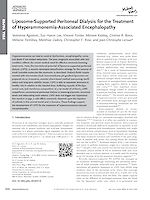
Liposome-supported peritoneal dialysis for the treatment of hepatic encephalopathy.
Post-doctoral, ETH Zurich, Suisse
Printemps 2015
Publications connexes
Vincent Forster, Valentina Agostoni, Giovanna Giacalone, Soohyeon Lee, Meriam Kabbaj, Christina Bosoi, Mélanie Tremblay, Christopher Rose, Jean-Christophe Leroux.
Valentina Agostoni, G. Giacalone, Cristina R. Bosoi, Christopher F. Rose, Jean-Christophe Leroux.
Introduction: Liposome-supported peritoneal dialysis (LSPD) has recently emerged as a versatile biodetoxification platform for improving the peritoneal extraction of small ionizable molecules via the intraperitoneal instillation of transmembrane pH-gradient liposomes.1 In a proof-of-concept study, these scavenging vesicles efficiently trapped weak bases/acids (e.g. ammonia), and were subsequently withdrawn together with their toxic cargo at the end of the dialysis session.1 We investigated here the translational potential of LSPD for treating hyperammonemia-associated hepatic encephalopathy, a life-threatening condition arising from impaired liver functions. The initial steps towards the clinical development of this technology consisted in optimizing the manufacturing process, assessing efficacy and safety in appropriate animal models, investigating interferences with drugs commonly administered to liver impaired patients, and establishing the extraction fingerprint of LSPD fluids. Methods: LSPD fluids were prepared by an osmotic-shock based method, sequentially mixing liposome aqueous suspensions with a hypertonic citrate solution (acidic) and an isotonic xylitol-based solution (alkaline).2 Efficacy experiments were performed in a rat model of secondary biliary cirrhosis induced by bile duct ligation.2 After 4 consecutive 4-h dialysis sessions with LSPD or a control fluid, brain edema was measured by densitometry, and plasma and dialysate ammonia concentrations determined by enzymatic assay. The immunogenicity of LSPD fluids was assessed in a porcine model of complement activation-related pseudoallergy (CARPA).2 For the interaction study, nine drugs commonly taken by liver impaired patients (e.g. antibiotics, β-blockers, diuretics) were tested for their influence on the in vitro ammonia scavenging activity of LSPD fluids. The metabolites’ fingerprints of LSPD or conventional PD, prior and after dialysis in healthy rats, were established by mass spectrometry. Results: LSPD fluids were prepared via an innovative, osmotic shock-based method overcoming sterilization and long-term stability issues.2 The liposomal suspensions outperformed conventional PD fluids in lowering plasmatic ammonia levels, and attenuating brain edema in cirrhotic rats and did not trigger any hypersensitive reaction in pigs, a gold standard model of CARPA.2 In general, the in vitro ammonia uptake of LSPD fluids was barely affected by the presence of the selected drugs in the incubation medium. Only the β-blocker propranolol considerably lowered the liposome scavenging capability. Metabolomics studies revealed a similar extraction profile between conventional PD and LSPD, confirming that important endogenous metabolites other than ammonia were not preferentially removed by LSPD. Conclusion: LSPD appeared as a promising strategy for ammonia detoxification, a first valuable alternative to extracorporeal dialysis, when the latter is not available or too risky. Acknowledgements. This work was supported by Versantis AG, the Swiss National Science Foundation (31003A_124882), Swiss Commission for Technology and Innovation (17525.1 PFLS-LS), and the OPO Foundation. The authors thank Seroscience Ltd (Budapest, Hungary) for their involvement in the safety studies.

Liposome-supported peritoneal dialysis for the treatment of hepatic encephalopathy.
Valentina Agostoni, Soo Hyeon Lee, Vincent Forster, Meriam Kabbaj, Cristina Bosoi, Mélanie Tremblay, Matthias Zadory, Christopher F. Rose, Jean-Christophe Leroux.
Hyperammonemia can lead to cerebral dysfunction, encephalopathy, coma, and death if not treated adequately. The poor prognosis associated with this condition reflects the unmet medical need for effective ammonia-lowering treatments. Here, the translational potential of liposome-supported peritoneal dialysis (LSPD), a recently-developed detoxification strategy for the removal of small ionizable molecules like ammonia, is described. Dialysis fluids supplemented with micrometer-sized, transmembrane pH-gradient liposomes are prepared via an innovative, osmotic shock-based method overcoming sterilization and long-term stability issues. LSPD is able to sequester ammonia in healthy rats in relation to the injected dose, buffering capacity of the liposomal core, and membrane composition. In a rat model of cirrhosis, LSPD outperforms conventional peritoneal dialysis in lowering plasmatic ammonia levels and attenuating brain edema. LSPD does not trigger any hypersensitive reaction in pigs, a side effect commonly observed upon the injection of colloids in this animal model and in humans. These findings support the development of LSPD for the treatment of hyperammonemia-induced encephalopathy.
Liposome-Supported Peritoneal Dialysis in the Treatment of Severe Hyperammonemia.
Valentina Agostoni, Vincent Forster, Cristina Bosoi, Mélanie Tremblay, Christopher Rose, Jean-Christophe Leroux.
Purpose: Hyperammonemia (HA) is a clinical condition characterized by toxic increases in systemic ammonia levels predominantly resulting from inherited or acquired impairments in hepatic detoxification (e.g. cirrhosis). If not treated, HA can lead to irreversible brain damages and death in severe cases. The poor prognosis associated to this condition reflects the still unmet clinical need for a safe, fast, and efficient ammonia-removal therapy. Hemodialysis, the current standard of care for treating severe HA, suffers indeed some major drawbacks as it is technically difficult to implement, not readily available in hospitals and highly risky for some patients (e.g., newborns and patients suffering from hemodynamic instability). Peritoneal dialysis (PD) may represent a valuable therapeutic alternative as it is a less invasive procedure since it uses the peritoneum as a semipermeable filter and the peritoneal cavity as a dialysis chamber. However, its clinical application is limited by its lower clearance capacity compared with hemodialysis. To address this problem, we report herein a novel dialysis fluid based on transmembrane pH-gradient liposomes (acidic core) that efficiently scavenge the excess of ammonia from the body. The ammonia-removal efficacy of this system was assessed in a rat model of cirrhosis induced by bile duct ligation. The cirrhotic rats develop hyperammonemia, and consequently brain edema. Methods: Liposome-supplemented peritoneal dialysis (LSPD) fluids (350 mOsm/L, pH 6.5), were prepared by sequentially mixing sterile liposomes aqueous suspensions, obtained by film hydration method, with a hypertonic acidic citrate buffer (pH 2) and an isotonic xylitol-based basic solution (pH 12.4). The first step allowed the encapsulation of an acidic medium in the vesicles core by means of an osmotic shock; the second established the transmembrane pH-gradient. Dose-response studies were first performed in healthy Sprague-Dawley rats by injecting LSPD fluids (60 mL/kg) with increasing liposome concentrations (4, 8 and 16 mM) in the peritoneal space, and evaluating their ammonia extraction efficiency over 4 h of dialysis. Efficacy studies were then performed in a rat model of secondary biliary cirrhosis induced by bile duct ligation. Control normal rats (SHAM) underwent a sham operation. Five weeks after the surgery, two different groups of cirrhotic rats (LSPD and PD) received 4 consecutive PDs performed every other day with LSPD or a conventional glucose-based PD solution (injected dose = 50 mL/kg). One group (positive control) did not receive any treatment. At the end of the study, the brain edema was assessed by measuring the brain water content in the frontal cortex by densitometry method. The ammonia concentration in dialysate and plasma samples was determined by enzymatic method using a commercial kit. Results: LSPD was shown to efficiently scavenge ammonia in the peritoneal space of healthy rats in a dose-dependent manner. The extracted ammonia levels progressively increased over time reaching a concentration of 0.48 ± 0.05 mM, 1.25 ± 0.2 mM and 1.72 ± 0.24 mM in fluids supplemented with liposomes 4, 8 and 16 mM, respectively. In light of these results, the LSPD fluid 8 mM, which exhibited a good ammonia uptake, was tested in a cirrhotic rat model. Compared to the control PD solution, the liposomal formulation showed an enhanced ammonia extraction capability. At the end of each dialysis session, the ammonia concentrations in the liposome-supplemented dialysate exceeded those obtained with the control solution by 7-fold. Importantly, this improved ammonia clearance led to a significant attenuation of the brain edema. Indeed after four consecutive LSPDs, the brain water content of cirrhotic rats was significantly decreased and reverted to normal levels. On the contrary, no significant reduction was observed with the control solution. Plasma ammonia levels were also found to significantly decrease after treatment with LSPD fluid but not with the control PD solution. Conclusion: These findings demonstrate that LSPD is a promising strategy to improve the clearance capacity of PD towards ammonia, and pave the way for a less invasive, safe and efficient approach for treating severe HA. Financial support from the Swiss Commission for Technology and Innovation (17525.1 PFLS-LS) is acknowledged.
Nouvelles connexes

Article dans Adv Func Mater-Agostoni-2016
8 years ago

